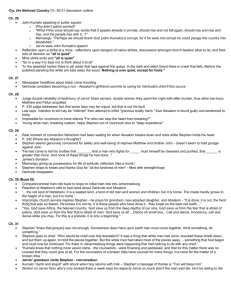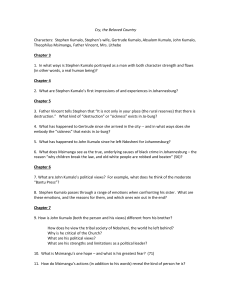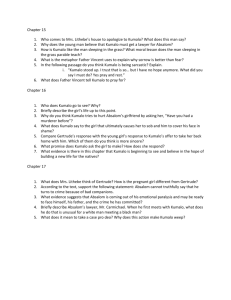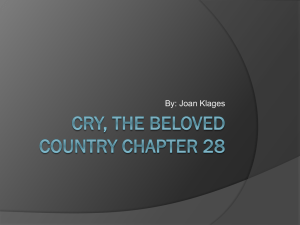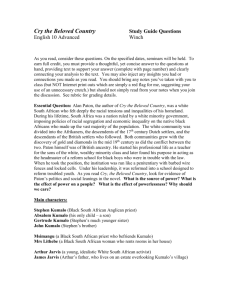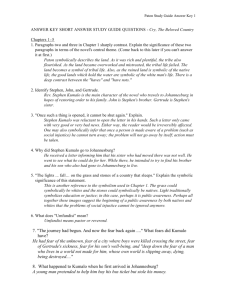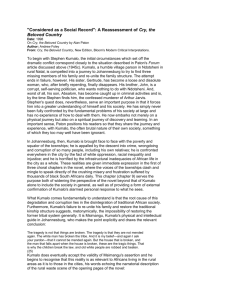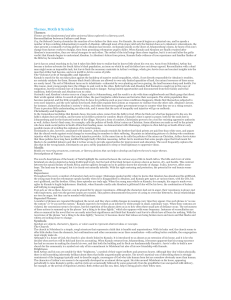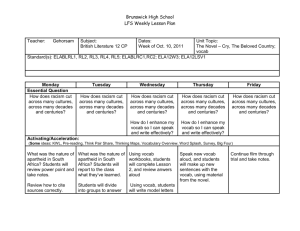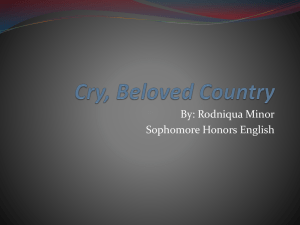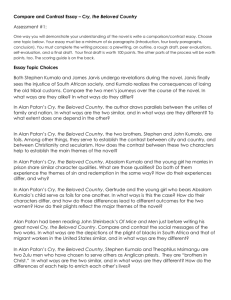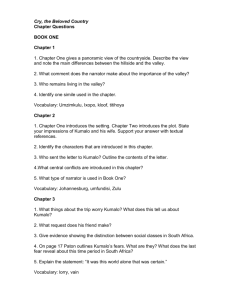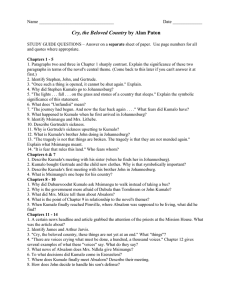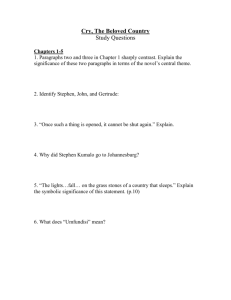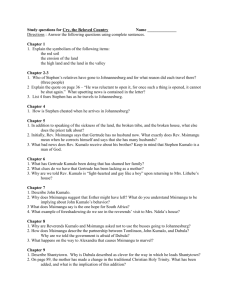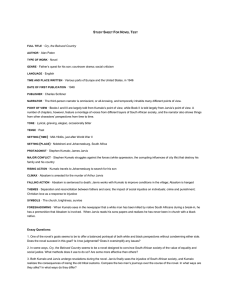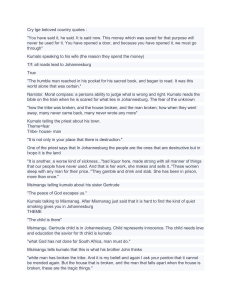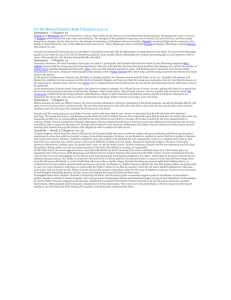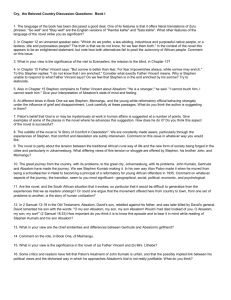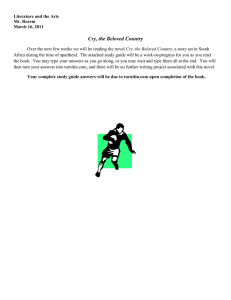Cry, the Beloved Country
advertisement
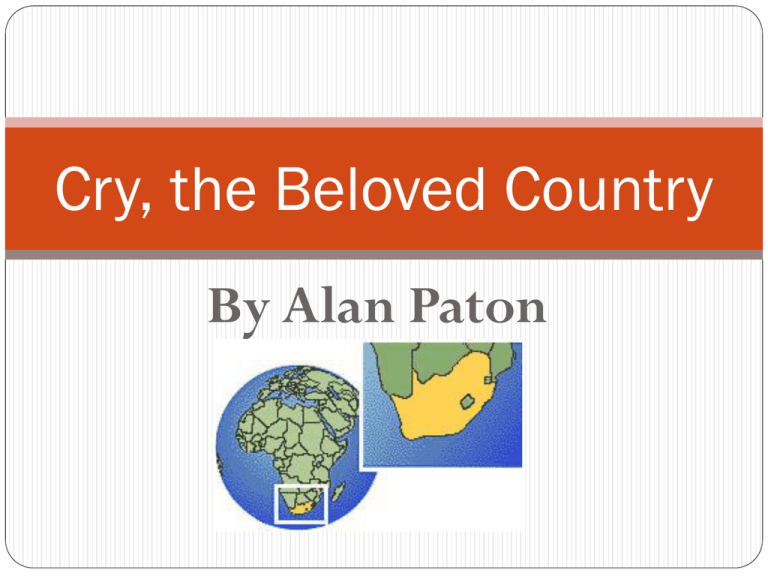
Cry, the Beloved Country By Alan Paton List at least two possible themes from your text. Provide three examples from the story to support how each of these themes is developed. Fear causes impulsive actions. Absalom Kumalo kills Arthur Jarvis because he is scared. Gertrude Kumalo goes to Johannesburg because she is worried about her husband. Gertrude Kumalo works as a prostitute because she fears she won’t be able to provide for her son any other way. Being removed from the support and guidance of family members can result in devastating consequences. When Absalom leaves his parents, he gets involved with criminal activity. The young people of Johannesburg are away from their tribes and families and get into trouble. The villages have very little crime compared to the big cities. Introduction – compare/contrast through second person point of view Rich fertile hills Desolate valleys The rich areas are fertile The land can’t hold rain and not overused The land is green and wet The birds sing and the streams are dry The ground is overused and doesn’t grow crops like it used to The only people left are the old men and old women, mothers and children Transitions The book transitions from one chapter to another using time, location, and point of view. There are also style differences that separate each chapter. In chapter one a narrator contrasts the rich and poor areas of South Africa, but chapter two is made up almost entirely of dialogue. Within the story, transitional words and conjunctions are used to connect events: “So they all talked of the sickness of the land…So they broke up…” (42). Plot Basic situation: Rev. Kumalo is looking for his son. Complication: He travels to Johannesburg, stays with some priests, finds his sister and brother, visits a reformatory looking for his son, and finally meets his son's pregnant girlfriend. Climax: He finds out his son is accused of murdering Arthur Jarvis and visits him in prison. Falling Action: his son marries the girl, his son is found guilty in a trial, and his son is hanged. Resolution: He forms a friendship with Mr. Jarvis who "has no anger in him" and even helps Kumalo by offering money for a new church. Protagonist Protagonist – - a main character; wants something or is trying to solve a problem Reverend Stephen Kumalo is the protagonist. He wants to find his family members, especially his son. Antagonist Antagonist –fights against the main character or protagonist Various forces/people work against Rev. Kumalo at different times in the novel. Johannesburg, apartheid, Absalom Kumalo, Gertrude Kumalo, James Jarvis, The man who stole his money... Dynamic Dynamic – Character development - how a character changes or grows throughout a story A character who changes in the novel (a dynamic character) is James Jarvis. He learns from his son, even after his son's death. He starts out believing in segregation, but feels differently by the end of the novel. James Jarvis More Characters Static – Stephen Kumalo, John Kumalo, Mrs. Kumalo Round – James Jarvis, Rev. Stephen Kumalo, Theophilus Msimangu, Absalom Kumalo Flat – Gertrude’s son, The young man, Father Vincent, Absalom’s girlfriend, Margaret Jarvis, John Harrison, Mr. Harrison, Author’s son Characterization Direct Indirect showing telling When an author describes a character When an author through his/her speech, actions, states directly what thoughts, appearance, or other characters' thoughts about that a character is like or character. gives a direct "But she did not go at once. She description. rubbed one bare foot against the other, she rubbed on finger along the edge of “The small child...” the umfundisi's table" (35). (35). The above sentence is much more descriptive than "She was hungry." Setting Johannesburg, South Africa 1940’s The 1940’s were a time of racial segregation, enforced inequality, and prejudice. The crime rate was high, and attacks on whites by black agitators caused panic among the country’s white citizens. Black South Africans found themselves adrift as the traditional tribal cultures gave way to the lure of the cities, and many South Africans were left without any moral or social organization to turn to. Whites held a monopoly on political power, and they did nothing to alleviate the extreme poverty among black South Africans, which in turn led many young black men to crime. The gold mines, which were so vital to South Africa’s economy, depended on cheap black labor to remain profitable, and as a result, the workers were paid barely enough to survive. But those in power inevitably broke up attempts to strike or seek a better wage. All information on this slide is from: http://www.sparknotes.com/lit/cry/context.html Point of View - multiple 1st person 3rd person objective "I have had the experience -I bring a letter umfundisi. of meeting a young woman here in Johannesburg..." (37) 2nd person "Below you is the valley of the Umzimkulu..." (33) -A letter, eh? Where did you get it, my child? (35) 3rd person limited "Yes he remembers." (128) 3rd person omniscient "The people looked at the sky...and did not know whether to be glad or sorry." (290) Inferences 1. _(no particular chapter; figured out by the middle of the story)__ inference: Absalom Kumalo was a good person who made a tragic mistake. We come to this conclusion based on what we know about his family, the environment he was in, and the fact that he is honest, even when he knows it will lead to his death. 2. “She looks at him sullenly, like an animal that is tormented. (61)” inference: Sullenly is defined for us through the context of the sentence. It means gloomy. 3. "But she did not go at once. She rubbed one bare foot against the other, she rubbed one finger along the edge of the umfundisi's table." (35) inference: She was hungry. 4. “-I am ashamed to walk with you.” (101) inference: He is not ashamed of the priest. He is ashamed of himself because of how he acted toward Absalom’s pregnant girlfriend. 5. Chapter two inference: The fact that Rev. Stephen Kumalo hesitates to open the letter forshadows that it may contain bad news. The letter does contain bad news; his sister is sick. Consider the literary elements we studied, and explain the impact of the author’s choices. How is the author’s style unique? Did the author make good choices, or could the book have been improved if any of the elements were different? Alan Paton’s style is unique because it is not consistent. He uses multiple points of view and seems to be telling the story of South Africa from multiple perspectives. He breaks some traditional rules of writing by using dashes instead of quotation marks for dialogue and by writing in many different styles. He uses short sentences in some parts of the book and very long sentences in other sections. Fragments and colloquial language add to the flavor of the book, such as: -stay well...go well -umfundisi -my child, the mother, the father, my friend ...hard names for a Zulu who has been schooled in English (ch. 4, pg. 45) -I am ashamed to walk with you. (101) -I am glad to greet you. (49) All of these examples, along with use of second person point of view, make the reader feel as if he or she is in South Africa with the characters. The multiple styles make this book as eclectic as the country in which it takes place. Analyze the use of words in the story. Provide at least one example of each. Explain how the word choices affected your appreciation, enjoyment, and/ or understanding of the story. The words used in this story fit the culture and the social class of the characters. The language changes based on the character and the location. The language used in Johannesburg is different from the villages. The dashes make it easy to see when a new person is speaking and is a nice alternative to quotation marks. Sometimes it is difficult to understand parts of the story because of the unfamiliar language, but the context of the story helps, and many phrases and words are repeated throughout the story to help a reader’s comprehension. Figurative Language Simile – “And always behind them the dim walls of the wattles, like ghosts in the mist.” (32) 2. Metaphor – “the tribe was broken…the house broken…the man broken…” (42) Sound Devices alliteration - “He held it in his hand.” (30) – repetition of the h sound assonance - “My own son, my own sister, my own brother. They go away and do not write any more. Perhaps it does not seem to them that we suffer.” (31) - long and short o sound is repeated consonance - “People looked at him with interest and respect.” (35) –t sound is repeated at the end of words Tone – fear, page 29 Sentence Structure – dialogue is mostly simple sentences, and narration is mostly complex and compound sentences.
